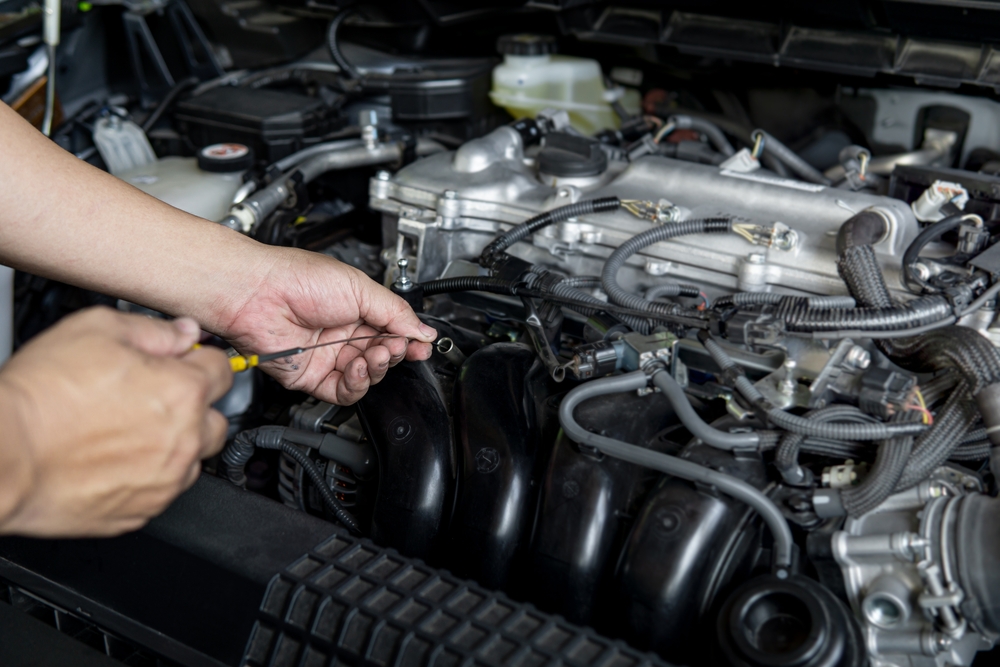
When shopping for a reliable used car, auto insurance is one of the many factors you should consider. Buying a reliable used car can be a time-consuming experience. You need to properly check out the car’s condition and be sure you’re getting a safe, well-maintained car for the best deal at a fair price – and not a lemon.
Having a mechanic look at the car for you before you buy is a good idea. Many shops will give a car a look before you buy. A second opinion is always valuable.
Before you drive it off the dealership lot or out of the driveway of a private seller, here are some tips to help you decide if that second-hand car is a good deal.
Why a Used Car Checklist is a Good Idea
Unless you have a stellar memory, you need a checklist when you go car shopping. If you don’t have a list, you may forget to inspect some important components of the vehicle in question.
It doesn’t matter if your list is handwritten on the back of an envelope or detailed precisely in a spreadsheet. As long as it makes sense to you, it’s fine. You should break the list into manageable bites so it’s easy to navigate.
Lay Some Groundwork for Buying a Used Car
Before you get out there and start visually and physically inspecting used vehicles, you should have some plans about what types of cars you have in mind, how much you want to spend, and how you plan on paying for your new-to-you vehicle. If you can narrow it down to a short list of potentials, you’ll save yourself a good deal of time (and some gas money).
Think about what you want: a pickup truck, a sports car, an SUV, a sedan? Are you fond of one of Big Three automakers? Or prefer something imported? Looking for low mileage? Coming up with a short list of what you are interested in will help you narrow down your search.
Once you have some idea of your preferred types, it’s time to decide what you want to spend. Check the Kelley Blue Book value to find out the fair market value, to give you an idea of what a private seller or a dealership should be charging. This is a good time to get your ducks in a row as far as how you are going to pay for new wheels. If financing, see if you can get a pre-approval, so you won’t waste your time if it turns out that nobody will loan you the money or put you on a monthly payment plan. It’s a good rule of thumb to make sure your credit score is up to par, if possible.
Save Yourself Some Time by Doing a Used Car Pre-Check from Home
If you’ve narrowed down your list to a few favorites, you can start your inspection from the comfort of your home. If, for some reason, these items aren’t available, you’ve just saved yourself some time (and gas money) and can scratch that option off your list.
If you are looking at a private sale vehicle, ask the seller why they are selling the car. You may not get an honest answer, but it’s worth asking questions to find out how long they’ve owned it, if they are the original owner, if it has a transferrable warranty and if its been in an accident or had any issues. Pay close attention to their answers. A sales person at a dealership may not have the answers to these questions, but many offer an inspection as part of the deal.
Here are 3 other things you can check before leaving your sofa.
1. A Clean Title
This is an important document – and not just for the obvious reasons. Of course, you want to make sure the seller has the right to sell the car (especially a private party) and has the title (or bank documents) in hand. But you’ll also want to check the VIN (vehicle identification number) to make sure the car has a clean title and not a branded title, meaning it has been declared a total loss and salvaged.
2. Detailed Maintenance Records
The seller should be able to provide you with maintenance records that, hopefully, show that the auto has had its regular oil changes and other tune-ups consistently and on schedule. If they don’t have these records, this should be red flag that something may not be right with this car. If the vehicle has had any other issues, such as manufacturer’s recalls, you should be able to get those records to make sure the current owner followed through.
3. Vehicle History Report
If the seller cannot provide a vehicle history report, it’s worth your money to buy one. You’ll need the VIN. This report will tell you important things about the vehicle, including any funny business with the title or otherwise shady doings, such as previous collisions or out-of-state title registrations.
The Used Car Exterior Exam
You’ve done just about all you can do without actually getting out there and kicking the tires. And the exterior exam of the auto can give you some good information about the car’s condition.
1. Kick the Tires
As we mentioned, you’ll want to kick the tires. Maybe not literally, but you can learn a lot by examining the wheels and tires. Obviously, tires can be replaced, but rims and hubcaps can be telltale signs of wear and tear. If the rims and hubcaps show signs of “curb rash”, it’s an indicator that there may be suspension and steering damage due to someone driving into curbs.
If you feel the tires that come with the car should be part of the deal, check the tread. Make sure all tires are the same brand – mismatched tires may compromise safety. Important: Make sure the key for the locking lug nuts is present, if applicable.
2. Check the Body and Frame
What you want to see here is consistency throughout and around the vehicle. All cars have small gaps in between body panels, but these gaps should be the same. For example, if there is any gap on the hood, it should be the same on both sides. Obviously, any signs of putty products or other home remedies for damages to the car’s body is a red flag.
While you are walking around the vehicle, check for frame issues. If the car is not sitting level, if there are major problems with the bumpers or if you spot new bolts in the hood and trunk, this vehicle may have been in an accident.
3. Look Carefully at the Paint
The vehicle’s paint job should be consistent all over the body. It’s a second-hand car, so some small scratches are to be expected. Look carefully at the paint for dents, flaking, scratches or rust. Inspect the paint from different angles. Deep scratches signal potential for rust. Scratches on the undercarriage could indicate damage from an accident.
Inspecting the Used Car Interior
You will want to make sure the interior of the car is suitable. After all, when you are using your new-to-you wheels, this is where you – and your family and friends – will spend most of your time. Besides having the potential to be unpleasant, interior issues can be expensive to fix.
1. Give the Auto the Sniff Test
Some cars just smell funny. Sometimes you can get some relief from a funky odor with a deep clean or other techniques. But sometimes, you just have to pass. Tobacco smoke leaves a lingering odor that is hard to fix, so if it smells like a chain smoker lived there and that bothers you, move on.
Other smells are just as important. Cars that have been exposed to water or flood damage may retain a musty or moldy aroma. Check with a flashlight for rust on seat frames, under floor mats and in the trunk. Anything of this nature should cause you to look elsewhere.
2. Study the Upholstery
The upholstery should be clean, at the very least. If there are stains, tears or the seats are worn through in places, walk away unless you plan to pay for repairs and replacements. If the upholstery is leather, it shouldn’t be cracked.
3. Check the Instrument Panel
Turn the key in the ignition to the “On” position. The dashboard should momentarily light up with the vehicle’s warning systems – and then go dark. If one or more of the instrument warning lights is not coming on, it may or may not be a problem in that it probably won’t affect how the car drives, but if you have to get it fixed at some point, it could be expensive. You are mostly looking for the “Check Engine Light,” the “Air Bags Light” and the “ABS Light.” You want them to light up, but you also want them to go dark. If the dashboard lights stay lit, you’ve got a serious problem.
4. Roll all the Windows Up and Down
This should be a smooth operation. All windows should move up and down from both the master switch at the driver’s position, as well as individually. Any jerking could indicate a window motor issue, which could be an issue in the long run.
5. Play with the Driver’s Controls
Most modern cars these days are equipped with Bluetooth, cruise control, stereo audio buttons, etc. Some are on the steering wheel, others are on the stereo console. Check all the buttons. If something doesn’t work, it could be an indication of a more serious issue.

Scrutinize the Engine of a Used Car
Unless you are a mechanic, you cannot do everything to make sure this vehicle is in good mechanical shape and not a lemon. Taking it to a mechanic for a checkup is a good last step, after the vehicle has passed all the other tests. Make sure the vehicle has the proper working ABS system. There are some things you can do first in regards to the engine.
1. Look at the Engine and Drivetrain
Check under the hood to make sure all the hoses and belts are in good condition – they should have no cracks and the radiator hose should not be soft. Ask if the car’s timing belt has ever been replaced, and if so, when. On average, timing belts can last from 60,000 to 100,000 miles. If the car has a steel timing chain, you need check with your mechanic. Some manufacturers state the chain is good for the life of the car, while others advise replacement at a certain mileage.
2. Examine the Vehicle’s Fluids
Before the car has been turned on and driven, you should check the various fluids, including the oil (yellow or amber), coolant and brake fluids (see-through). Be a little wary of a car where every dipstick is at or above the full mark. Normal, healthy cars don’t need someone to fill up the fluids right before the car is inspected. The fluids should be between the full and the add marks on the dipstick.
Pull up the dipstick, wipe it clean, reinsert it and pull it out. You’ll be getting your hands dirty, as you need to feel these fluids between your fingers. They should feel smooth without any grittiness. This is the best way to check levels.
Time to Fire it Up
If you’ve been reading these tips, you should probably be driving it to a mechanic for that last professional inspection. Before and during the drive, there are a few last-minute items to check off your own used car checklist.
1. Observe the Running Engine
With the engine running, inspect thoroughly for any leaks or signs of corrosion. After a couple of minutes, look at the transmission dipstick to make sure the transmission is completely filled. The fluid should be pink or red. It may be darker in older models, but definitely should not look or smell burnt.
2. Look for Exhaust Smoke
With the car running in neutral, step on the gas and ask a friend to check the color of the exhaust fumes. If they see blue or black smoke, it means you’re burning oil and the engine has some internal problems.
3. Listen for Unusual Noises
With the car running and before you drive it, listen to the engine. You shouldn’t hear anything rattling, knocking, screeching or otherwise out-of-the-normal car noises. Continue listening while you are actually driving.
4. Keep an Eye on the Instrument Panel
Once the engine is running, keep an eye on the instrument panel. If you see anything lighting up, especially if it is red, there may be a problem. In most modern cars, green or blue lights provide information. Make sure you have an owner’s manual to check.
5. Put the Transmission through its Paces
Before driving, move the shifter through the various gears. You shouldn’t feel anything jolting or hear any knocking as you move through the gears. An automatic transmission should shift gears quietly and smoothly. Loud noises could mean a problem. If it has a manual transmission, make sure the gears don’t grind when you shift. That indicates they’re out of sync and you could end up with major repair problems.
Time to Take it For a Test Drive
It’s finally time to get behind the wheel and give the car a test drive. If the car has made it this far on your checklist, you can start to feel some confidence. But not too much! The driving test is critical for those final, important, items on your checklist. Make sure you drive it on streets and on the highway.
1. Pump the Brakes
When you’re test-driving (ideally, in an empty parking lot) at a higher speed (30 mph or more), press hard on your brakes to check them. Don’t hit them hard enough to skid, but make sure in an emergency they will be reliable. As you are driving, brakes should feel smooth and should be noiseless.
2. Steer the Course
Because the steering is a critical safety factor, check it while you are driving slowly at first. If there is a major problem with the steering, you don’t want to find out at 50 mph. Take some turns and get a feel for how the car handles. It shouldn’t feel like you are manually turning the car. The steering should be doing the work. But it also shouldn’t feel too loose, like you have to spin the steering wheel to make a turn. Take special note of any shaking or unresponsiveness when you check the steering. This could indicate potential problems in the long run.
3. Check the Acceleration and Shock Absorbers
Your pre-owned vehicle shouldn’t hesitate when you ask it to quickly speed up. If you put the pedal to the metal, you shouldn’t hear weird noises or see dashboard lights. If you aren’t getting enough power to accelerate quickly, there might be a problem. You shouldn’t be bouncing up and down too much if the shock absorbers are in good shape.
4. Test the Climate
Once the vehicle is warmed up, you should be able to get toasty warm air or ice-cold air conditioning with the push of a button or the turn of a knob. If you aren’t feeling it, there may be potential problems with the AC compressor or the heater control – expensive issues to fix.
Find Affordable Car Insurance Online For Your New Used Car
Congratulations! Your used car has passed your checklist! Now, you’ll need to find a cheap auto insurance policy before getting on the road. Freeway has some great options for your budget. You can get a quick car insurance quote online, call us at (800) 777-5620 or stop by one of our convenient locations.



